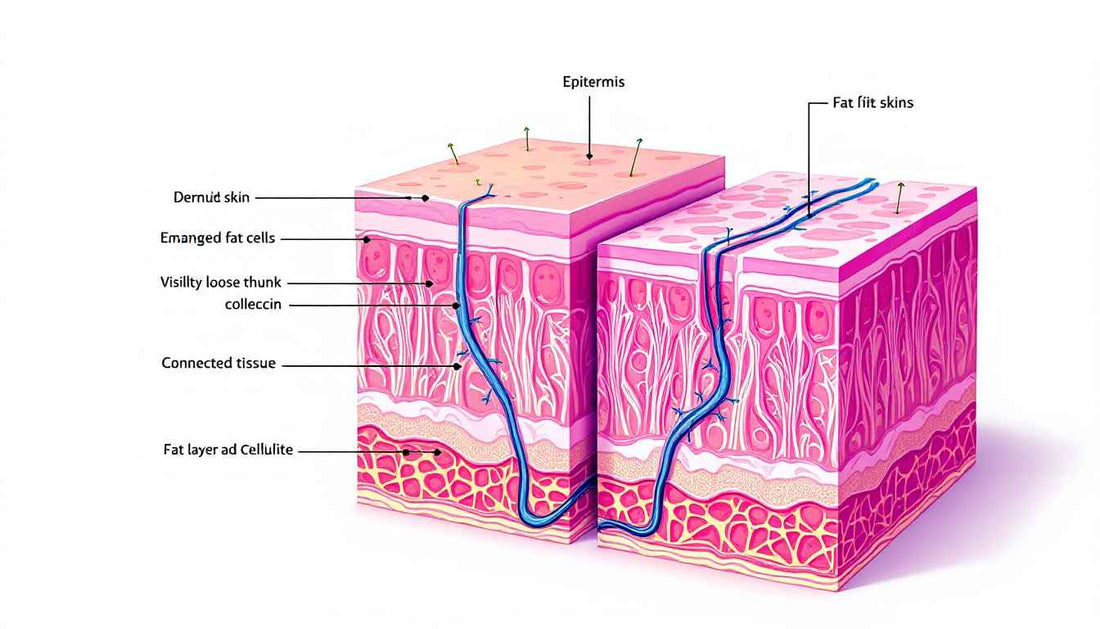
How Does Cellulite Form? The Science Behind Dimpled Skin
Share
Have you ever asked yourself, "How does cellulite form?" While many people deal with cellulite, few understand what’s happening beneath the skin. Cellulite isn't just about fat—it's a complex interaction of skin structure, fat cells, connective tissue, and circulation. In this article, we’ll break down the science of cellulite formation, explain why it affects some people more than others, and explore what you can do to manage it.
Featured Snippet Answer:
Cellulite forms when fat cells beneath the skin push up against connective tissue while fibrous cords pull the skin down, creating a dimpled or lumpy appearance on the surface.
The Science of Cellulite Formation
Cellulite appears when:
- Fat cells expand beneath the skin.
- Connective tissue bands (septae) pull the skin downward.
- The uneven pressure creates a dimpled appearance.
This process is most visible in areas with a higher concentration of fat and less muscle tone—typically the thighs, buttocks, hips, and abdomen.
Step-by-Step Breakdown of How Cellulite Forms
1. Fat Accumulation
Everyone has fat cells, but when these cells enlarge due to weight gain or hormonal changes, they press upward against the skin.
2. Weak Connective Tissue
Bands of collagen (septae) connect skin to deeper tissues. If these bands stiffen or shorten, they pull the skin down unevenly.
3. Skin Structure Differences in Women
Female connective tissue is arranged in vertical columns, which allows fat to protrude more easily compared to men, whose tissue forms a crisscross pattern.
4. Reduced Circulation
Poor blood flow means fewer nutrients reach skin cells and connective tissue, weakening them over time and making cellulite more noticeable.
Contributing Factors That Accelerate Formation
Hormones
Estrogen, insulin, noradrenaline, and thyroid hormones influence fat storage and connective tissue behavior.
Genetics
Your genes affect skin elasticity, fat distribution, and how your body stores and metabolizes fat.
Lifestyle
Lack of physical activity, poor diet, smoking, and dehydration all contribute to cellulite development.
Internal Anatomy of Cellulite
- Epidermis (outer layer): Thinner with age, allowing cellulite to be more visible.
- Dermis (middle layer): Contains collagen and elastin; if weakened, dimpled skin becomes more pronounced.
- Hypodermis (fat layer): Enlarged fat cells push up, forming lumps and bulges.
Internal Link:
Learn more about What Is Cellulite and the Causes of Cellulite.
Prevention and Reduction Tips
1. Strength Training
Build muscle under areas prone to cellulite to improve skin’s smoothness.
2. Hydration
Drink plenty of water to keep skin cells plump and elastic.
3. Diet Rich in Collagen
Consume bone broth, leafy greens, and vitamin C to support connective tissue.
4. Massage & Cupping
Promote circulation and break up stagnation. Explore Cellulite Massage Techniques and Cupping Therapy Process.
FAQs
What happens under the skin when cellulite forms?
Fat cells push up while collagen bands pull down, creating dimples on the surface.
Why do women get more cellulite than men?
Due to differences in connective tissue structure and hormonal influences like estrogen.
Can you reverse cellulite formation?
You can reduce its appearance, but it’s difficult to eliminate completely. Lifestyle changes and treatments help.
Does building muscle reduce cellulite?
Yes. Increasing muscle mass can smooth out the skin by filling in the uneven areas underneath.
Internal Links:
CTA:
Want to take control of cellulite from the inside out? Download our FREE guide: "The Science-Backed Cellulite Prevention Plan" and start building healthier, smoother skin today!
